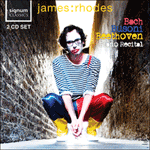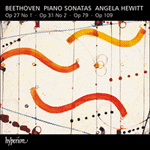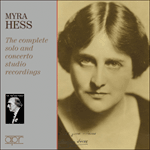
Welcome to Hyperion Records, an independent British classical label devoted to presenting high-quality recordings of music of all styles and from all periods from the twelfth century to the twenty-first.
Hyperion offers both CDs, and downloads in a number of formats. The site is also available in several languages.
Please use the dropdown buttons to set your preferred options, or use the checkbox to accept the defaults.

 PERFORMANCE
PERFORMANCE RECORDING
RECORDING

The sonata was almost ready by September, but further delays meant that it was not sent to Schlesinger until around January 1821. After numerous proof-reading problems it finally appeared around October, and was dedicated to Maximiliane Brentano. She was daughter of Beethoven’s friends Franz and Antonie Brentano, who had been assisting him in various ways; Antonie is also probably the unnamed addressee of Beethoven’s amorous letter of 1812 to his ‘Immortal Beloved’.
The first movement is unlike any other, perhaps betraying its origins as an intended teaching piece, for it combines a very short first subject and a slow, leisurely second subject in a different metre. As in all Beethoven’s works in the key of E, the keynote remains the same for all movements, but the second movement here changes from major to minor in a stormy prestissimo that follows the first movement without a break.
The finale consists of a theme and six variations. The theme resembles a sarabande (slow triple metre with a slight accent on the second beat) and is marked ‘Songful with most intimate feeling’. In his autograph score Beethoven labelled it ‘Gesang’ (‘song’), but Schlesinger’s edition changed this to ‘Gesangvoll’, perhaps with Beethoven’s approval; either way, Beethoven wanted to draw attention to the lyrical, vocal style of the theme, which is eminently singable apart from covering a rather large range. The variations contrast sharply with each other: Variation 1 retains the song-like character of the theme, but Variation 2 is light and delicate, while the Bach-like Variation 3 contains vigorous runs throughout. Variation 4 is even slower than the theme, but with more decoration, and Variation 5 is quick and energetic like Variation 3. Variation 6 returns to the original tempo, but is gradually adorned with increasingly intricate figuration until it finally dies away, as if exhausted, to leave a fresh statement of the theme, without repeats. The theme, however, now seems cast in a completely new light, after what has gone before.
from notes by Barry Cooper © 2019
La sonate était presque prête en septembre, mais à cause de retards supplémentaires, elle ne fut envoyée à Schlesinger que vers le mois de janvier 1821. Après beaucoup de problèmes de corrections, elle parut finalement vers le mois d’octobre avec une dédicace à Maximiliane Brentano. C’était la fille des amis de Beethoven Franz et Antonie Brentano, qui l’avaient aidé de bien des façons; Antonie est en outre peut-être la destinataire inconnue de la lettre d’amour que Beethoven écrivit en 1812 à son «Immortelle Bien-Aimée».
Le premier mouvement n’est comparable à aucun autre, trahissant peut-être ses origines de pièce à visée pédagogique, car il allie un très court premier sujet et un second sujet lent et calme d’une métrique différente. Comme dans toute les œuvres de Beethoven écrites en mi majeur, la tonique reste la même pour tous les mouvements, mais ici le deuxième mouvement passe du majeur au mineur dans un prestissimo tempétueux qui s’enchaîne au premier mouvement sans interruption.
Le finale se compose d’un thème et de six variations. Le thème ressemble à une sarabande (rythme ternaire lent avec un léger accent sur le deuxième temps) et est marqué «très chanté avec beaucoup d’expression». Sur sa partition autographe, Beethoven porta la mention «Gesang» («chant»), mais l’édition de Schlesinger remplaça ce mot par «Gesangvoll» («très chanté»), peut-être avec l’accord de Beethoven; dans un cas comme dans l’autre, Beethoven voulait attirer l’attention sur le style vocal et lyrique du thème, qui est parfaitement chantable en dehors du fait qu’il couvre une tessiture plutôt large. Les variations sont très contrastées: la Variation 1 conserve le caractère mélodieux du thème, mais la Variation 2 est légère et délicate, alors que la Variation 3 dans le style de Bach contient des traits vigoureux du début à la fin. La Variation 4 est encore plus lente que le thème, mais plus ornée, et la Variation 5 est rapide et énergique comme la Variation 3. La Variation 6 revient au tempo d’origine, mais se pare peu à peu d’une figuration de plus en plus complexe avant de finir par disparaître, comme si elle était épuisée, au profit d’une nouvelle exposition du thème, sans reprises. Toutefois, le thème semble maintenant apparaître sous un jour totalement nouveau, après ce qui s’est passé auparavant.
extrait des notes rédigées par Barry Cooper © 2019
Français: Marie-Stella Pâris
Im September war die Sonate fast fertig, doch neue Verzögerungen führten dazu, dass Schlesinger sie erst um den Januar 1821 herum erhielt. Nach zahlreichen Schwierigkeiten im Zuge der Korrektur erschien sie schließlich im Oktober mit einer Widmung an Maximiliane Brentano. Sie war die Tochter des mit Beethoven befreundeten Ehepaars Franz und Antonie Brentano, die ihn auf unterschiedliche Weise unterstützt hatten; Antonie ist wahrscheinlich auch die Ungenannte, an die Beethoven 1812 seinen Liebesbrief an die „unsterbliche Geliebte“ schrieb.
Der erste Satz ist ohne Parallele in Beethovens Werk, was möglicherweise daran liegt, dass er als Übungsstück gemeint war; er kombiniert ein sehr kurzes erstes Thema mit einem langsamen, entspannten zweiten Thema in anderem Metrum. Wie in allen Werken Beethovens in E-Tonarten bleibt der Grundton durch alle Sätze derselbe, wechselt aber hier mit dem zweiten, einem stürmischen, direkt an den ersten Satz anschließenden Prestissimo, von Dur nach Moll.
Das Finale besteht aus einem Thema mit sechs Variationen. Es ähnelt einer Sarabande—langsamer Dreiertakt mit leichter Betonung der zweiten Zählzeit—und ist überschrieben „Gesangvoll mit innigster Empfindung“. Im Manuskript hatte Beethoven es als „Gesang“ bezeichnet, doch Schlesinger änderte den Titel in „Gesangvoll“, vielleicht mit Zustimmung Beethovens. Beide Titel heben die lyrische und trotz seines großen Tonumfangs sangliche Qualität des Themas hervor. Die Variationen bilden scharfe Gegensätze: Behält die erste den liedhaften Ton des Themas bei, so wirkt die zweite Variation leicht und zart, und die dritte, an Bach erinnernde enthält durchweg kraftvolles Passagenwerk. Variation 4 ist noch langsamer als das Thema selber, aber auch stärker ausgeziert; Variation 5 ist rasch und energisch wie Variation 3. Variation 6 kehrt zum ursprünglichen Tempo zurück, wird aber mit zunehmend verästelten Figurationen durchzogen, bis sie schließlich gleichsam erschöpft verklingt. Sie macht der Wiederaufnahme des Themas Platz, diesmal ohne Wiederholungen. Doch erscheint es nun, nach allem, was geschehen ist, in einem völlig neuen Licht.
aus dem Begleittext von Barry Cooper © 2019
Deutsch: Friedrich Sprondel
 Bach, Busoni & Beethoven: Piano Recital Bach, Busoni & Beethoven: Piano RecitalThis album is a perfect example of me as a musician and piano-fanatic choosing works that for as long as I can remember have blown my mind. [James Rhodes, 2010]» More |
 Beethoven: Beethoven Unbound Beethoven: Beethoven UnboundA comprehensive new cycle of the Beethoven sonatas recorded live at London's Wigmore Hall during the pianist's epic fourth rendition of these masterpieces .» More |
 Beethoven: Piano Sonatas Opp 27/1, 31/2, 79 & 109 Beethoven: Piano Sonatas Opp 27/1, 31/2, 79 & 109Angela Hewitt’s next instalment of Beethoven, bookended by the great ‘Tempest’ and late E major sonatas.» More |
 Beethoven: The Final Sonatas Beethoven: The Final SonatasBeethoven's final three piano sonatas in consummate performances by Melvyn Tan, here making his first solo album for Signum.» More |
 Beethoven: The Last Three Piano Sonatas Beethoven: The Last Three Piano Sonatas‘Kinderman is evidently a thoughtful musician whose ideas about this great music are worth pondering’ (BBC Music Magazine) ‘A good deal to admire’ (American Record Guide)» More |
 Myra Hess - The complete solo and concerto studio recordings Myra Hess - The complete solo and concerto studio recordings‘In one disc after another you are drawn towards a deeply personal quality that endeared her to thousands … this set will prompt endless reapprai ... ‘A stunning collection of music played by one of the most talented of British pianist’ (MusicWeb International)» More |

